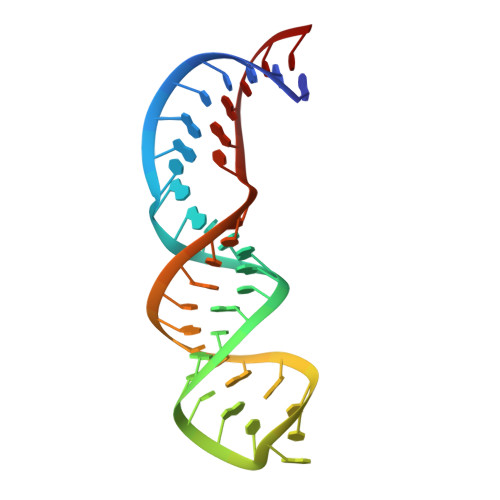HnRNP A1 Alters the Structure of a Conserved Enterovirus IRES Domain to Stimulate Viral Translation.
Tolbert, M., Morgan, C.E., Pollum, M., Crespo-Hernandez, C.E., Li, M.L., Brewer, G., Tolbert, B.S.(2017) J Mol Biol 429: 2841-2858
- PubMed: 28625847
- DOI: https://doi.org/10.1016/j.jmb.2017.06.007
- Primary Citation of Related Structures:
5V16, 5V17 - PubMed Abstract:
Enteroviruses use a type I Internal Ribosome Entry Site (IRES) structure to facilitate protein synthesis and promote genome replication. Type I IRES elements require auxiliary host proteins to organize RNA structure for 40S ribosomal subunit assembly. Heterogeneous nuclear ribonucleoprotein A1 stimulates enterovirus 71 (EV71) translation in part through specific interactions with its stem loop II (SLII) IRES domain. Here, we determined a conjoined NMR-small angle x-ray scattering structure of the EV71 SLII domain and a mutant that significantly attenuates viral replication by abrogating hnRNP A1 interactions. Native SLII adopts a locally compact structure wherein stacking interactions in a conserved 5'-AUAGC-3' bulge preorganize the adjacent helices at nearly orthogonal orientations. Mutating the bulge sequence to 5'-ACCCC-3' ablates base stacking in the loop and globally reorients the SLII structure. Biophysical titrations reveal that the 5'-AUAGC-3' bulge undergoes a conformational change to assemble a functional hnRNP A1-RNA complex. Importantly, IRES mutations that delete the bulge impair viral translation and completely inhibit replication. Thus, this work provides key details into how an EV71 IRES structure adapts to hijack a cellular protein, and it suggests that the SLII domain is a potential target for antiviral therapy.
Organizational Affiliation:
Department of Chemistry, Case Western Reserve University, Cleveland, OH, 44106-7078 USA.














